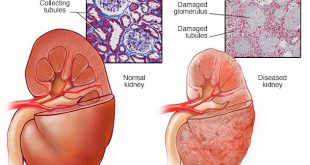Overview
Anaemia is what happens when your red blood cells are in short supply. Red blood cells carry oxygen via a protein known as haemoglobin from your lungs to all parts of your body, giving you the energy you need for daily activities.
The usual test to detect anaemia is a haemoglobin level. For a patient with CKD, anaemia is defined as a haemoglobin level less than 12 g/dL in women and less than 13.5 g/dL in men.
Anemia can cause you to:
- Look pale
- Feel tired
- Have little energy for your daily activities
- Have a poor appetite
- Have trouble sleeping
- Have trouble thinking clearly
- Feel dizzy or have headaches
- Have a rapid heartbeat
- Feel short of breath
Treatment of anaemia in CKD depends on the exact cause (see section below).
If anaemia is due to kidney disease, you will usually be treated with drugs known as Erythropoiesis stimulating agents (ESAs) and Iron supplements (see Iron therapy)
Epidemiology of anaemia in CKD
Anaemia is common in patients with Chronic Kidney Disease (CKD) and affects up to 50% of patients with stage 3-5 CKD1 (see Staging of CKD). In the United States, a large national heath survey showed that the prevalence of anaemia increases with increasing loss of kidney function (1% at eGFR 60, 9% at 30 and 33% at eGFR 15ml/min/1.73 m2).2 In addition, the severity of anaemia worsens with worsening levels of kidney impairment.3
Female CKD patients and patients with diabetes are at a greater risk of developing anaemia earlier in the course of their disease.1
Causes of anaemia in CKD
In CKD, anaemia mainly develops because of decreased production by the kidneys of a hormone called erythropoietin. This important hormone tells your bone marrow to make red blood cells. When you have kidney disease, your kidneys cannot make enough erythropoeitin. This causes your red blood cell count to drop and anaemia to develop.
Iron deficiency is also common in patients with chronic kidney disease (see causes of iron deficiency in CKD). Other causes for anaemia in CKD include a significant reduction in circulating red blood cell lifespan due to uraemia (high levels of waste products in the blood), reduced bone marrow response to erythropoietin due to uraemic inhibitors, deficiencies of folate or vitamin B12, as well as other causes of anaemia which apply to the general population (see topic Anaemia in Adults)
Complications
If untreated, anaemia can cause serious problems. Anaemia can make your heart work harder and may lead to a type of heart disease called left ventricular hypertrophy (LVH). Many people with CKD will develop LVH even before they reach stage 5 CKD 4 but anaemia is only one of the contributory factors.
LVH causes the heart to function poorly and can lead to heart failure (inability of your heart to pump enough blood to your body), abnormal heart rhythms, insufficient supply of oxygen to the heart (ischaemic heart disease), interruption of blood supply to the heart (heart attack) and sudden cessation of heart function (sudden cardiac arrest). For patients on dialysis, it has been shown that anaemia increases the rates of death and hospitalisation.5
Anaemia can also worsen other health problems that you may already have, for example chronic heart or lung problems. Anaemia may also contribute to the progression of chronic kidney disease.
Benefits of correction
Treating anemia is important because :
- Correction of anaemia can reduce LVH6
- You will have more energy to do your daily tasks.
- Your quality of life gets better.
- Your ability to exercise improves.
- You will be less likely to need blood transfusions – this avoids potential transfusion-related complications such as allergic reactions, viral infections, iron overload and development of antibodies which may increase chances of rejection of a future kidney transplant.
Targets for anaemia correction
It is recommended that treatment of anaemia should maintain haemoglobin levels between 10-11.5g/dL.7
References:
- McClellan W, Aronoff SL, Bolton WK et al (2004).The prevalence of anaemia in patients with chronic kidney disease. Curr Med Res Opin. Sep. 20(9):1501-10
- Coresh J, Astor BC, Greene T, et al (2003). Prevalence of chronic kidney disease and decreased kidney function in the adult. Am J Kidney Dis. Jan. 41(1):1-12. [abstract]
- Hsu C-Y, McCulloch and Curhan GC (2002). Epidemiology of Anemia Associated with Chronic Renal Insufficiency among Adults in the United States: Results from the Third National Health and Nutrition Examination Survey. J Am Soc Nephrol 13: 504–510
- Foley RN, Parfrey PS, Harnett JD, et al (1995) Clinical and ecocardiographic disease in patients starting end stage renal disease therapy. Kidney Int. 47:186-192.
5. Locatelli F, Pisone RL, Combe C et al (2004). Anaemia in haemodialysis patients of five European countries: association with morbidity and mortality in the Dialysis Outcomes and Practice Patterns Study (DOPPS) Nephrol Dial Transplant 19: 121–132
- Schmid H, Schiffl H, Lederer SR. (2011). Erythropoiesis-stimulating agents, hypertension and left ventricular hypertrophy in the chronic kidney disease patient. Curr Opin Nephrol Hypertens. Sep; 20(5):465-70.
- Kidney Disease: Improving Global Outcomes (KDIGO) Anemia Work Group (2012). KDIGO Clinical Practice Guideline for Anemia in Chronic Kidney Disease. Kidney int. Suppl. 2:279-335
| Last Reviewed | : | 27 May 2016 |
| Writer | : | Dr. Sunita Bavanandan |
| Accreditor | : | Dr. Hooi Lai Seong |
 PENDIDIKAN PESAKIT Kementerian Kesihatan Malaysia
PENDIDIKAN PESAKIT Kementerian Kesihatan Malaysia
